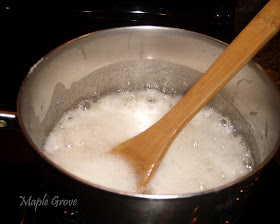 Peanut brittle is an old fashioned candy that is irresistible and unforgettable. I started making it years ago, and it has become a fall favorite in our home.
Peanut brittle is an old fashioned candy that is irresistible and unforgettable. I started making it years ago, and it has become a fall favorite in our home.You'll be surprised how easy it is to make! Your family will love it, your friends will rave about it, and you'll want to start a new tradition of making it every year.
Here's the recipe and tips learned along the way.
First gather what you'll need to get started:
Old Fashioned Peanut Brittle
2 cups sugar
1 cup Kayro light corn syrup
1/2 cup water
1 16 oz. jar dry roasted peanuts
1/4 cup butter
2 tsp. baking soda
1 tsp. vanilla or butter nut flavoring
(Tip: Grease a large cookie sheet and the rim of a large saucepan with butter.)
Place sugar, syrup and water in the saucepan and bring to boil, stirring constantly.
Continue to heat, stirring constantly until the mixture reaches the hard ball stage (260°F).
Add peanuts and butter. Heat to hard crack stage (310°F). Turn off heat.
Add baking soda and vanilla. Mixture will foam up. Stir thoroughly and mixture will go down.
Spread the mixture onto the greased cookie sheet and let it set until it cools completely.
(Caution: the mixture is extremely hot and will burn you if you touch it. The cookie sheet will also become very hot. To protect the counter surface, place a wooden board underneath it before you pour out the mixture.)
Break the cooled brittle into pieces.
Store at room temperature in a container with a tight fitting lid.
(Tip: To easily clean the saucepan, fill it with water and heat it to boiling. Let it sit for a few minutes until the brittle residue dissolves. Pour out the water and wash the saucepan with steel wool.)
(Note: On a hot or humid day, the peanut brittle often turns out tacky, so I always make it in the fall or winter months. If you make it in the summer, you'll want to have the air conditioner on.)
For more information on the cooking stages of sugar syrup candies, read at The Science of Cooking.







